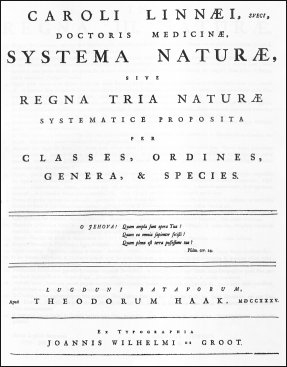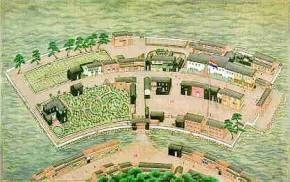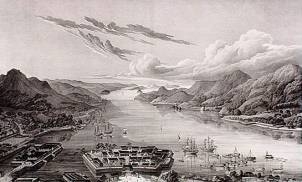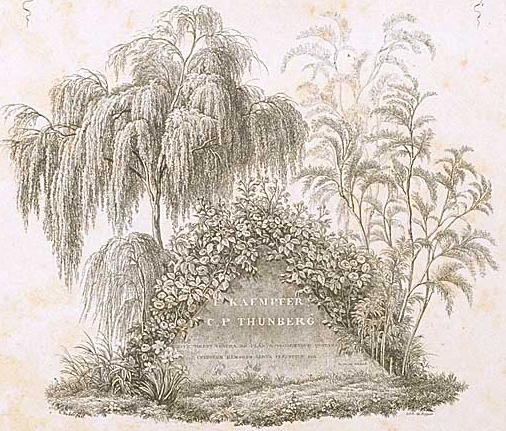Introduction
Classifying and naming the objects of nature
In the 15th and 16th century naturalists broadened their horizon. The discovery of the New World by Columbus in 1493 as well as the invention of the microscope around 1600 – to mention just two occurrences – meant that new areas opened up. Microcosm and macrocosm, till then always believed to be reflective of each other, developed to dynamic and self-contained domains. In order to research and describe the teeming diversity of phenomena along with their Babylonian variety of names, it seemed necessary to be more restrictive and to reconsider the old scientific methods. Therefore in contrast to the medieval tradition the supernatural and numinous (divine, holy) were excluded from natural science in the narrower sense. The whole scale from the inanimate to God and the angels was no longer described, instead only what was basically visible and observable. Furthermore, plants and animals were not categorised any more according to the Aristotelian tradition (e.g. "birds living on land" versus "birds living on water") but according to their exterior characteristics. These measures, however, did not suffice and remained unsatisfactory as long as the principles for describing and structuring varied from author to author and a commonly accepted coordinated system in which any object of nature had its place and name did not exist.
Around 1730 Carolus Nilsson Linnaeus (in 1762 ennobled Carl von Linné, 1707-1778), a medical and natural science student at Uppsala in Sweden, had made it his business to "describe all flowers accurately, to divide them into new classes, to reform names and families in a completely new way".[1] In 1735 Linnaeus travelled to Holland to complete his studies with a doctoral thesis at the University of Harderwijk. The promotion took only one week. Linnaeus then journeyed on to Amsterdam and Leiden where he published a small work entitled Systema Naturae. In this work he outlined for nature as a whole what he had, as a student, resolved to do for plants only: a reform of science by means of a new method of differentiation and identification.
The first step in wisdom consists of, as Linnaeus states in the Systema Naturae, knowing the "things themselves", and for this a "true idea of the objects" is required. He then continues: "objects are distinguished and recognised by classifying them methodically and giving them appropriate names. Therefore, classification and nomenclature will be the foundation of our science."[2] The Systema Naturae was Linnaeus' programmatic writing for a series of works using different approaches to demonstrate how the complete flora and fauna could be classified and made comprehensible by means of a "grid"[3] of classes and names.
 |
| Front page of the first edition of the Systema Naturae in 1735 |
Linné's work from 1735 marks the beginning of a new scientific access to nature. But Linné did not revolutionise science, he did not initiate an abrupt "paradigm shift". Previous to Linné, other researchers had already classified nature (Ray, Tournefort). Linné, however, took other and – as it turned out – more suitable characteristics for differentiation: the sexual organs in plants, i.e. the stamens and pistils (shocking enough for some contemporaries); and the mammary glands in mammals. When it came to naming, Linné's improvement consisted of introducing a practical, binary nomenclature according to which each species could be named unequivocally (Critica Botanica, 1737), in place of the complex scientific names which had been formed without using any system. Linné's ideal was a consistent system of concepts that, nevertheless, was open for new objects. For him such a system was the pre-condition "to perceive in the apparent greatest confusion of things the greatest order of nature."[4]
Deshima and Western knowledge (rangaku)
Around 1640, the last Spaniards and Portuguese had been expelled from Japan. After that the only Europeans tolerated in Japan were tradesmen of the Dutch East Indian Company (VOC) who were allowed to hold a trading post on the tiny, artificial island of Deshima (also spelled Dejima) in the bay of Nagasaki (see pictures).[5] At the beginning of the 18th century the Japanese rulers realised that not only articles of trade but also certain technologies (medicine, astronomy, geography, natural sciences etc.) were needed and gradually permitted the Dutch to partake in a restricted knowledge transfer.[6] Thus, for example, in the 18th century also the microscope was introduced to Japan, causing a stir there. The new sciences were called rangaku or yôgaku, literally "Dutch studies" or "Western Studies", respectively, representing Western sciences as a whole.[7]


The life on Deshima was monotonous and restricted to the islet itself. The VOC employees were permanently supervised by the Japanese authorities. One Dutchman went out of his mind and committed suicide, however, serious incidents like this occurred rarely. In principle only the Dutch were allowed to stay on Deshima, but in fact several Germans, Danes and Swedes acting as Dutch were on the island.[8] It was such illegal foreigners, two German and a Swedish doctor serving the VOC, who between the 17th and 19th century introduced and practised the new scientific methods in isolated Japan: Engelbert Kaempfer, Carl Peter Thunberg and Philipp Franz von Siebold, the "Three Scholars of Deshima".[9] These three researchers have strongly influenced the Western oriented natural sciences in Japan. Not until 1868, after the enforced opening of Japan, did scientists from Russia and America start to gain importance.[10]
Kaempfer, Thunberg and Siebold officially worked as physicians on Deshima[11], but they were also passionate naturalists, i.e. botanists and zoologists. Even though they stayed in Japan each for only a few years, they diligently applied the classification and identification methods to the mostly unexplored Japanese flora and fauna. Engelbert Kaempfer (1651-1713) published in 1712 the, until then, largest Flora Japonica written by a European. Carl Peter Thunberg (1743-1828), a pupil of Linné and from 1784 professor on his teacher's chair at Uppsala, was the first to assign the Linnean system to Japanese botany (Flora Japonica, 1784). Finally, Philipp Franz von Siebold (1796-1866) edited in Leiden, where he lived after his return from Japan, a monumental Flora Japonica (1835-1870) and a likewise multi-volumed Fauna Japonica (1833-1850), respectively.
The works of the three scholars complemented each other. Without doubt, the basis for a scientific exploration of Japan was established by Engelbert Kaempfer. Linné himself[12] had already drawn on Kaempfer's Flora Japonica copiously. Thunberg as well owed a lot to Kaempfer's pioneer work. He took a copy of Kaempfer's Amoenitates exoticae with him to Japan and in his own Flora Japonica he followed up on Kaempfer's spadework. Additionaly, Thunberg dealt with Kaempfer twice in separate writings (Kaempferus Illustratus, "Kaempfer explained", 1780 and 1783). Siebold finally completed the preparatory work of Kaempfer and Thunberg, he even was acquainted with the old Thunberg to whom he maintained a friendly correspondence. In 1824 he raised a monument to his two predecessors in the garden of Deshima on the back of which a quotation from Virgil (Linné's motto) was engraved.[13] Uppsala in Sweden, Leiden in Holland and Deshima in Japan are the places which decisively shaped all three researchers. The method of systematic classification has been their shared scientific legacy to their temporary host country.
 |
| Monument for Kaempfer and Thunberg in Deshima (drawing from Siebold’s Flora Japonica) |
The historical merits of Kaempfer, Thunberg and Siebold for the development of modern Japanese sciences have often been mentioned. Over and above this aspect of the formation of sciences, however, the question still remains as to how applicable and informative the descriptions of the three scholars still are today. This can only be decided in individual cases, as has been done in the case of Thunberg's Flora Japonica where several descriptions of plants have since been revised. Therefore, from their zoological descriptions we want to single out two adjacent grid fields (in Linnean nomenclature: two sub-species), namely the Japanese dogs and the Japanese wolf.
The dogs and wolves of Japan have been for some time the subject of national and international research. Dogs accompanied the first settlers of the archipelago and have been part of the Japanese culture from the beginning.[14] Man and dog joined to form a hunting team in pre-agricultural times, but their close proximity to one another was not only the usual symbiotic relationship between humans and domesticated animals – rather, it was the exceptional case of a real partnership in which both sides mutually benefited.[15] The wolf, in contrast, did not become the subject of scientific interest until the 17th century, and then – after his extinction – was re-discovered by the Japanese at the beginning of the 20th century as a "national monument". Since then, impassioned disputes about its zoological status have arisen.
In the first two sections of our study we trace how dogs and wolves in Kaempfer and Thunberg first come into the focus of Western observers. Subsequently, the third section tries to clarify how far Siebold's Fauna Japonica came up to the Linnean ideal of describing and naming a species accurately. The subject-matter for this reconstruction is thus the zoological description of the Japanese wolf and of the Japanese dog, Canis hodophilax and Canis nippon, to use the scientific names introduced by Siebold's colleague C. J. Temminck in the Fauna Japonica. In this section we also refer to the concrete dog and wolf specimens that served as models for the zoological descriptions by Siebold and Temminck, respectively.
The section following thereafter outlines a short history of Japanese dogs and wolves based on unpublished manuscripts (Sieboldiana). These manuscripts are an indispensable complement to understand and correct Temminck’s in parts odd descriptions in the Fauna Japonica.
In the European as well as in the Far Eastern culture the dog and the wolf have always had a highly positive as well as negative symbolic value. An influential, anti-Western tract from 1825 entitled New Theses (Shinron) culminates for example in the statement: "Commoners must be made to despise foreigners as they would despise dogs and goats, to hate the barbarians as they would hate wild boars and wolves."[16] This polemic from the pen of a samurai prompted us to trace a little the connotations of the terms "wolf" and "dog". In the last part of our study therefore we use a small literary example, one of Aesop's fables entitled The Dog and the Wolf, in order to reflect on historical and cultural dependencies of the term "freedom". By doing so, we wish to indicate that an object of nature can be perceived not only as a scientific idea (Linné) but also as an aesthetic idea (Kant).
Finally, the appendix part contains transcriptions and translations of unpublished manuscripts that we have found in the Siebold archive of the University of Bochum, Germany, and in the archive of the Naturalis Museum at Leiden, The Netherlands. Some of these manuscripts are rendered as photostat facsimiles. Furthermore, we have reproduced in the appendix part unpublished pictures of Japanese dogs and wolves, drawn by the Dutch painter Carl Hubert de Villeneuve at Deshima.
Notes
[1] Linné in his autobiography Vita Caroli Linnaei, cited in Heinz Goerke: Carl von Linné. Arzt – Naturforscher – Systematiker, Stuttgart 1966, p. 107.– All translations, unless otherwise noted, are mine.
[2] Carolus Linnaeus: Systema Naturae, Observationes in Regna III Naturae, no. 10: "Primus est gradus sapientiae res ipsas nosse; quae notitia constitit in vera idea objectorum; objecta distinguuntur & noscuntur ex methodica illorum divisione & convenienti denominatione; adeoque Divisio & Denominatio fundamentum nostrae Scientiae erit."
Cited according to Carolus Linnaeus, Systema Naturae 1735. Facsimile of the first edition. With an introduction and a first English translation of the "Observationes" by M. S. J. Engel-Ledeboer and H. Engel, Nieuwkoop 1964, p. 19.
[3] The expression "grid" (French "trame" or "quadrillé") to characterise the method of classifying is used by Foucault in his classical work Les mots et les choses; see Michel Foucault: The Order of Things. An archaeology of Human Sciences. A Translation of Les mots et les choses. Vintage Books, Reprint New York 1994, p. 141, passim.
[4] "in summa confusione rerum apparenti, summus Naturae ordo conspiciatur" – Caroli a Linné: Systema naturae per regna tria naturae, secundum classes, ordines, genera, species, cum characteribus, differentiis, synonymis, locis, Editio Duodecima, Reformata [= twelfth edition], Holmiae (= Stockholm) 1766, T.1, P.1 [= Vol. 1], p. 13.
[5] There are two excellent presentations of Deshima available online:
| • | Marc Jason Gilbert: Deshima Island: A Stepping Stone between Civilizations, World History Connected 3.3 (2006) http://www.historycooperative.org/journals/whc/3.3/gilbert.html |
| • | Dejima Comes Back to Life: http://www1.city.nagasaki.nagasaki.jp/dejima/en/main.html |
How Deshima was organised and how the barracked everyday life looked like is described by Grant K. Goodman: The Dutch Experience, London and Dover, New Hampshire 1986, pp. 18-24. Additionally, Ken Vos: Dejima und die Handelsbeziehungen zwischen den Niederlanden und dem vormodernen Japan, in: Doris Croissant, Lothar Ledderose (Hrsg.): Japan und Europa 1543-1929, Berlin 1993, pp. 72-82. An authentic insight into the life on Deshima is provided by the official diaries of the VOC, see Paul van der Velde, Rudolf Bachofner (eds.): The Deshima Diaries. Marginalia 1700-1740, Tokyo 1992. Written from a Dutch point of view, there is also a chapter about Deshima in Germain Felix Meijlan: Japan. Voorgesteld in schetsen over de zeden en gebruiken van dat ryk byzonder over de ingezetenen der stad Nagasaky, Amsterdam 1830, pp. 27-43. Meijlan was Opperhoofd (head of the trading post) on Deshima from 1826 to 1830, i.e. he was one of Siebold's superiors in Japan.
[6] A. Querido: Dutch transfer of knowledge through Deshima: the role of the Dutch in Japan's scientific and technological development during the Edo period, Transactions of the Asiatic Society of Japan 18 (1983), pp. 17-37.
[7] Marius B. Jansen: Rangaku and Westernization, Modern Asian Studies 18 (1984), pp. 541-553; Tadashi Yoshida: Rangaku – Die Holländischen Wissenschaften, in: Croissant/Ledderose, Japan und Europa 1543-1929, Berlin 1993, pp. 94-106; Jiro Numata: The Acceptance of Western Culture in Japan, Monumenta Nipponica 19 (3/4), 1964, pp. 235-242.
The resistance against the Western knowledge is described by Bob Tadashi Wakabayashi: Anti-foreignism and Western learning in early modern Japan. The New Theses of 1825, Harvard University Press 1986.
[8] Frits Vos: Mihatenu yume – an unfinished dream: Japanese studies until 1940, in: Willem Otterspeer (ed.): Leiden Oriental Connections (1850-1940), Leiden – New York – Københaven – Köln 1989, pp. 354-377. See also Wolfgang Michel: Neue Materialien zum medizinischen Personal der VOC-Niederlassung in Japan, Genbun Ronkyû – Studies in Language and Literature, No. 10 (Kyushu University, Fukuoka), 1999, pp. 179-194.
[9] We have adopted this honorary title from Yojiro Kimura: Kaempfer, Thunberg and Siebold, Japanese Studies in the History of Science 15 (1976), pp. 1-13. See also the Tenno's explicit appreciation of Kaempfer, Thunberg and Siebold in a speech given to the Linnean Society of London as part of the Tercentenary Celebrations of the birth of Carl Linnaeus: His Majesty The Emperor of Japan: Linnaeus and taxonomy in Japan, Nature 448 (2007), pp. 139-140 (shortened version with a link to the long version). The Emperor is a scientist himself who publishes on fish phylogeny.
[10] Masuzo Ueno: The Western Influence on Natural History in Japan, Monumenta Nipponica 19 (3/4), 1964, pp. 315-339.
[11] For more on Kaempfer, Thunberg and Siebold as physicians in Japan see John Z. Bowers: Western medical pioneers in feudal Japan, The Johns Hopkins Press, Baltimore and London 1970; Gregor Heinrich Klövekorn: Ärzte auf Forschungsreisen, Leverkusen 1955; Fumi Takahashi: An Aspect of C. P. Thunberg's Contribution to Medical Care in Japan, The Journal of Japanese Botany 69 (5), 1994, pp. 363-371; Beatrice M. Bodart-Bailey: Beyond the borders of Europe. Engelbert Kaempfer's medical reserach and treatments, Revista de Cultura, International Edition 21 (2007), pp. 100-120; Wolgang Michel: Engelbert Kaempfer und die Medizin in Japan, in: Detlef Haberland (Hrsg.): Engelbert Kaempfer – Werk und Wirkung, Stuttgart 1993, pp. 248-293.
[12] Wolfgang Muntschik: Engelbert Kaempfer als Erforscher der japanischen Pflanzenwelt, in: Detlef Haberland (Hrsg.): Engelbert Kaempfer. Werk und Wirkung, Stuttgart 1993, pp. 222-247; Frans A. Stafleu: Linnaeus and the Linneans. The spreading of their ideas in systematic botany, 1735-1789, Utrecht 1971, p. 38.
Linné considered Kaempfer to be one of the best explorers ("Inter optimus numeratur peregrinators"), cited in John L. Heller: Linnaeus's Bibliotheca Botanica, Taxon 19 (1970), pp. 363-441 (here p. 403). As to the importance of Kaempfer's descriptions for zoology, see Lothar Weiß: Engelbert Kaempfers Name in der Nomenklatur der Zoologie, in: Sabine Klocke-Daffa, Jürgen Scheffler, Gisela Wilberz (Hrsg.): Engelbert Kaempfer (1651-1716) und die kulturelle Begegnung zwischen Europa und Asien, Lemgo 2003, pp. 283-303.
[13] Hans Körner: Die Würzburger Siebold. Eine Gelehrtenfamilie des 18. und 19. Jahrhunderts. Neustadt a. d. Aisch 1967, pp. 376-377 renders the Latin inscriptions on the front and back side:
E. KAEMPFER
C. P. THUNBERG
ECCE! VIRENT VESTRAE HIC PLANTAE
FLORENTQUE QUOTANNIS
CULTORUM MEMORES SERTA FERUNTQUE PIA!
and on the back side:
VIRTUTIS OPUS EST, FACTIS EXTENDERE VITAM VIRG.
Translation (according to Y. Kimura: Thunberg, the Founder of Modern Botany in Japan, Symbolae botanicae Upsalienses 22 (4), 1979, pp. 12-20):
E. Kaempfer
C. P. Thunberg
Behold! Your plants grow green here
and blossom every year.
The bring forth a wreath in solemn remembrance
of you who fostered them!
and:
Virtue is to enhance one's life by deeds Virgil
I have tried to identify Linné's motto in the works of Virgil. It seems to be a modification of lines 468/469 in the tenth book of the Aeneid: "sed famam extendere factis, hoc virtutis opus".
[14] For more on Japanese dogs see Yuichi Tanabe: The history of the Japanese dog, in: Michiko Chiba, Yuichi Tanabe, Takashi Tojo, Tsutomu Muraoka: Japanese Dogs. Akita, Shiba, and Other Breeds, Kodansha International, Tokyo, New York, London 2003, pp. 62-73; idem: Phylogenetic studies of dogs with emphasis on Japanese and Asian breeds, Proceedings of the Japan Academy, Series B 82 (10), 2006, pp. 375-387; Katuaki Ota: The dog, its domestication and development, with special reference to the origin of the native Japanese dog; idem: Morphological studies of Japanese native dogs, Report of the Society for Researches on Native Livestock 9 (1980), pp. 53-94 and 95-129 [Japanese, English summary pp. 232-237]; Hiroshi Sakamoto: Dog, Japanese, Kodansha Encyclopedia of Japan 2, Tokyo, New York 1983, pp. 124-126; Kotondo Hasebe: Über die Schädel und Unterkiefer von den steinzeitlich-japanischen Hunderassen, Arbeiten aus dem Anatomischen Institut der Kaiserlich-Japanischen Universität zu Sendai Vol. 10 (1924), pp. 1-33; Aaron Skabelund: Can the Subaltern Bark? Imperialism, Civilization, and Canine Cultures in Nineteenth-Century Japan, in: Gregory M. Pfugfelder, Brett L. Walker (eds.): JAPANimals. History and Culture in Japan's Animal Life, The University of Michigan, Ann Arbor 2005, pp. 195-243; Ulrike Thiede: Auf Haustierspuren zu den Ursprüngen der Japaner. Vorgeschichtliche und frühgeschichtliche Haustierhaltung in Japan, München 1998, pp. 73-85.
For more on the Japanese wolf see Brett L. Walker: The Lost Wolves of Japan. Foreword by William Cronon, University of Washington Press, Seattle and London 2005; John Knight: Waiting for Wolves in Japan: An Anthropological Study of People-Wildlife Relations, Oxford University Press 2003.
[15] Yuichi Tanabe: The Origin of Japanese Dogs and their Association with Japanese People, Zoological Science 8 (1991), pp. 639-651; Y. Tanabe, K. Ota, S. Ito et al.: Biochemical-genetic relationships among Asian and European dogs and the ancestry of the Japanese native dog, Journal of Animal Breeding and Genetics 108 (1991), pp. 455-478.
[16] Translated by Bob Tadashi Wakabayashi, Anti-foreignism, 1986, p. 273.